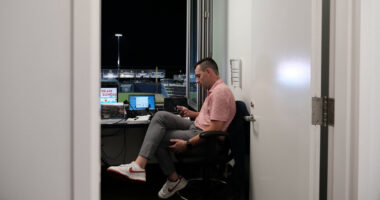
George Booth, the New Yorker cartoonist who created a world of oddballs sharing life’s chaos with a pointy-eared bull terrier that once barked a flower to death, and sometimes with a herd of cats that shredded couches and window shades between sweet naps, died on Tuesday at his home in Brooklyn. He was 96.
His daughter and only immediate survivor, Sarah Booth, said the cause was dementia.
In a typical Booth cartoon, a lot happens at once. A stunned dog leaps three feet in the air. A shocked cat bounds for an open window, knocking a newspaper from the hands of a shaken man — all as his frumpy wife stands in a kitchen doorway with blackened eyes, announcing: “Eyeliner is back!”
Or, as a score of cats lounge in a parlor and a man in pajamas scowls into a newspaper in his easy chair, his wife in the kitchen says: “Edgar, please run down to the shopping center right away, and get some milk and cat food. Don’t get canned tuna, or chicken, or liver, or any of those awful combinations. Shop around and get a surprise. The pussies like surprises.”
Or, as a neighbor with a big nose peers over a backyard fence, 10 cats bound out of a back door to freedom and scatter in all directions as a woman at the open screen door shouts after them: “Everyone be home by two o’clock!”
In a half century at The New Yorker, Mr. Booth drew roughly a score of covers and hundreds of zany cartoons for the inside pages. He became one of the most popular stars of a magazine whose readers relished sophisticated cartoon wit. His colleagues included Ed Koren, Jules Feiffer, Ed Sorel, Roz Chast, Art Spiegelman, David Levine, Charles Addams and George Price.
An affable artist who mostly resisted commercial offers, Mr. Booth was once asked to draw his trademark bull terrier as a gift for an anonymous celebrity. Instead, he recalled, he defiantly drew a “diseased chicken.” Later, he learned the gift was for President Ronald Reagan, who was “very gracious” when the two met in the Oval Office, he told The New York Times in 1993. “He never had me shot.”
“His work is about hope in the midst of what looks like calamity,” Bonnell Robinson, the curator of the 1993 Boston cartoon exhibition “Lines of the Times: 50 Years of Great American Cartoons,” told The Times. “Booth cartoons express the will to continue in the face of disaster.” One cartoon in the show depicted a parlor crammed with junk, pets and sundry relatives. “Attention everyone,” a woman chirps. “Here comes Poppa, and we’re going to drive dull care away!”
Mr. Booth’s pen-and-ink cartoons were collected in a dozen books, reproduced as artworks and sold in galleries. He lectured widely and joined discussion groups at schools, museums and cartoon-art exhibitions until he slowed down in his 90s.
The Booth repertoire was not all dogs and cats. His subjects ranged from the joys and perils of gardening and car repairs to banking and encounters with the Internal Revenue Service.
A couple sits before an inquisitor grasping their tax returns. The taxpayer slumps dejectedly in his chair, but his wife snaps angrily at the auditor, “Stop referring to my husband as ‘He whose ox is gored.’”
Mr. Booth also drew shaggy cave men, some with fine manners. Walking on all fours at the base of a cliff as a prehistoric hag peers down on them from the peak of an escarpment, one asks another, “Will your mother be coming down for dinner tonight?”
One of Mr. Booth’s best-known offerings — a two-page, 12-panel spread on Jan. 12, 1975, “Ip Gissa Gul” (meaning “Ape Gets a Girl”) — told of cave men who chance upon a furious, frustrated ape who wants a mate. He finally carries off a cave girl. The cave men later find the ape, the cave girl and six little creatures, and puzzle over the existence of the first cave children.
But the hands-down readers’ favorite was Mr. Booth’s mad-as-a-hatter bull terrier, who whirled in circles until dizzy, scratched himself a lot and posed glowering on a lawn beside a sign warning: “Beware! Skittish Dog.” He adorned New Yorker T-shirts and became the magazine’s unofficial mascot, nearly as notable as the top-hat-wearing Eustace Tilley, who appears on the cover once a year. As Lee Lorenz, The New Yorker’s art editor, once put it, “If you can’t recognize a Booth cartoon, you need the magazine in Braille.”
Mr. Booth had no explanation for his dog’s popularity. “I don’t try to analyze humor,” he told The Times in 1993. “You go nowhere doing that. A thing is funny or it’s not funny. I started drawing what I thought was an awful-looking dog.” After a letter writer asked if it was an English bull terrier, he said, “I went to the library, improved his breeding and made him an English bull terrier.”
Mr. Booth’s zoological record for one cartoon was 86 cats and 74 dogs, not counting the little clouds of flies he drew buzzing around some characters. “From a business perspective, it doesn’t make sense to draw 86 cats and 74 dogs,” he noted, because as a contract freelancer he was paid flat rates. “But,” he said, “I enjoy it.”
Parenthetically, Mr. Booth owned a few cats but no dogs, and a 1998 New Yorker profile explained that he “doesn’t much care for them — a surprise considering how well he captures them in his cartoons.”
After the Sept. 11, 2001, terrorist attacks, The New Yorker said it would not run cartoons that week. But Mr. Booth submitted one anyway, showing Mrs. Ritterhouse, a recurring character modeled after his mother, with head down and hands folded in prayer. Her cat covered its face with its paws. It was the only cartoon The New Yorker ran that week.
George Booth was born in Cainsville, Mo., on June 28, 1926. He and his brothers, Gaylord and James, grew up on a farm near Fairfax, Mo., a small town where their father, Earl (known as Billy), was a teacher and school administrator and their mother, Irma (Swindle) Booth, an artist, taught in a one-room country schoolhouse.
After graduating from Fairfax High School in 1944, he joined the Marine Corps and spent part of his enlistment with Leatherneck magazine in Washington. He was recalled to the Marines in the Korean War, and in 1952 he moved to New York. He studied at various art schools, and was the art director for a trade magazine representative for seven years.
He also sold cartoons to Collier’s, Look and The Saturday Evening Post, where he was finally hired as a staff artist. Just as he was to start work, the magazine folded (temporarily) in 1969. But an editor sent him with a recommendation to William Shawn, editor of The New Yorker, the holy grail for cartoonists.
Mr. Booth married Dione Babcock in 1958. She died on Oct. 26, also at their home in Brooklyn, from pancreatic cancer.
For decades, Mr. Booth lived in Stony Brook, N.Y., on Long Island. In 2014, after organ problems left him hospitalized for weeks, he moved to his daughter’s home in Brooklyn, where he continued to work. His wife joined them in Brooklyn at the onset of the pandemic.
He last contributed to The New Yorker in 2019, but his most recent appearances there, all in January this year, were the cover drawing of the Jan. 24 issue, an interview with his daughter and a short online documentary about his life and career.
His cartoon collections included “Pussycats Need Love, Too” (1981), “Omnibooth” (1984), “Booth Again!” (1989), “The Essential George Booth” (1998) and “About Dogs” (2009). His work was also featured in anthologies, including “The New Yorker Book of Cat Cartoons” (1990) and “The New Yorker Book of Dog Cartoons” (1992).
The National Cartoonists Society recognized his work with its Gag Cartoon Award in 1993 and its Milton Caniff Lifetime Achievement Award in 2010. Mr. Booth is to be inducted, now posthumously, into the Society of Illustrators Hall of Fame on Thursday at the organization’s annual awards banquet in Manhattan.
Some Booth pets had fine tastes in music, and ankles. A naughty cat is carried off by its mistress in an inglorious neck-and-bottom hold. An angry saxophone player rubs his wounded ankle. And the man of the house, holding his violin bow after an interrupted duet, leans over solicitously, and says: “I do apologize, Rinehart. The cat has never bitten anyone previously.”
Alex Traub contributed reporting.
Source: | This article originally belongs to Nytimes.com








